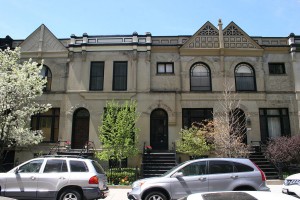
WASHINGTON, D.C. – In recognition of LBGT Pride month, U.S. Secretary of the Interior Sally Jewell announced Friday that the Henry Gerber House in Chicago, Illinois, has been designated a National Historic Landmark, becoming the nation’s second LGBT related property to achieve such recognition. Once the residence of noted gay rights activist Henry Gerber, the home was where the nation’s first chartered LGBT rights organization, the Society for Human Rights, was formed in 1924.
This is in direct contrast to the recent demolition debacle of the Michels-Carey house in San Diego, the initial headquarters to San Diego’s fledgling LGBT rights movement, which was unceremoniously demolished by developers several weeks ago. This was despite a pending formal hearing for a historic national registry listing for the site.
In honoring the Gerber House in Chicago Secretary Jewell said, “The National Park Service is America’s storyteller, and it is important that we tell a complete story of the people and events responsible for building this great nation. As we honor the pioneering work of Henry Gerber and the pivotal role this home played in expanding and fighting for equality for all Americans, we help ensure that the quest for LGBT civil rights will be told and remembered for generations to come.”
In a continuing effort to chronicle the history of the gay rights movement, Secretary Jewell joined local leaders at the Stonewall Inn in New York City in May 2014 to announce that the National Park Service was launching an LGBT initiative to help better tell the story of all Americans. The initiative includes a theme study to be released in 2016, part of the National Park Service tradition to document and interpret civil rights history.
“The City of Chicago is deeply honored by this historic designation, which will be a fitting tribute to a great civil rights pioneer who fought to make our nation truer to our values of equality and opportunity for all,” said Mayor Rahm Emanuel. “Henry Gerber was a great Chicagoan who dedicated his life to breaking down barriers of discrimination against LBGT Americans. This designation will help to teach generations of children about his important contributions to our city and our country.”
The Gerber House now becomes one of more than 2,500 noteworthy archaeological and historic properties recognized by the National Historic Landmarks Program. The Stonewall Inn in New York City’s Greenwich Village is the only other National Historic Landmark listed primarily for its association with LGBT history and heritage.
“The struggles and achievements of Henry Gerber within the walls of this house resonate in the ongoing LGBT civil rights movement,” said National Park Service Director Jonathan B. Jarvis. “The desire to share his story is part of the National Park Service’s ongoing commitment, as it approaches its Centennial in 2016, to preserve and tell a more complete, inclusive, and diverse history of our country.”
The house also served as the headquarters and meeting place for the Society for Human Rights. The Society’s members held lectures, published a newsletter that was the earliest-documented gay-oriented periodical in the country, and worked to change the minds of legal and political authorities. They hoped to challenge, through educational programs and community outreach, the contemporary discourse that discriminated against LGBT people.
The Society’s chartered status and newsletter were unprecedented in the history of the gay rights movement in the U.S. and preceded better-known efforts by more than two decades. Although the house was the site of the earliest documented efforts toward LGBT emancipation, the social and political climate led to the swift dissolution of the Society in 1925 after police arrested Henry Gerber and several other members. Although no warrant was produced, Mr. Gerber was taken into custody and his belongings confiscated. The organization’s collapse illustrates substantial obstacles in the struggle for civil rights.
Established in 1935, the National Historic Landmarks Program is administered by the National Park Service on behalf of the Secretary of the Interior. The agency works with preservation officials, private property owners, and other interested partners to nominate properties for designation. Nominations are reviewed by the National Park System Advisory Board, which makes recommendations to the Secretary of the Interior. Once designated, the property owner receives a designation letter, plaque, and technical preservation advice.
The National Historic Landmarks Program is one of more than a dozen programs administered by the National Park Service that provide states and local communities with technical assistance, recognition, and funding to help preserve our nation’s shared history and create close-to-home recreational opportunities.











